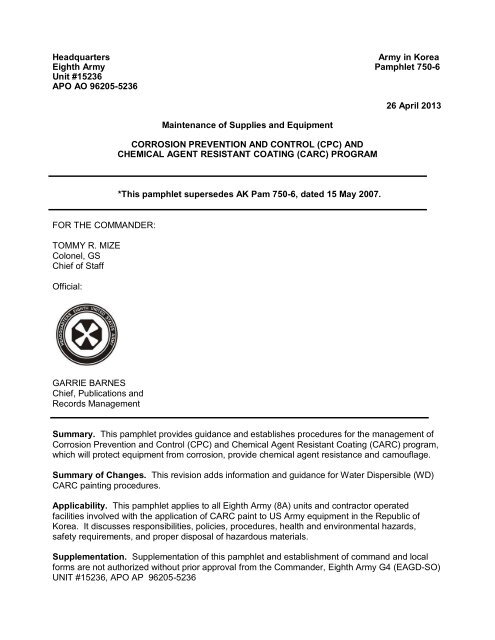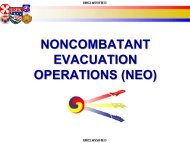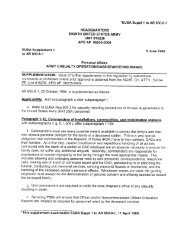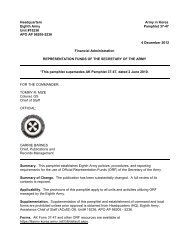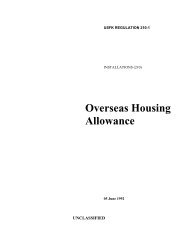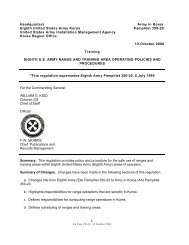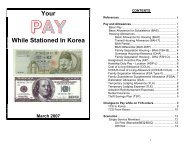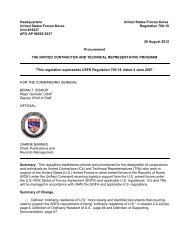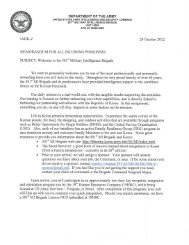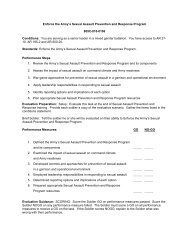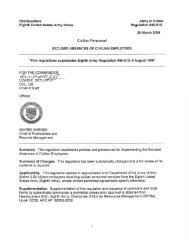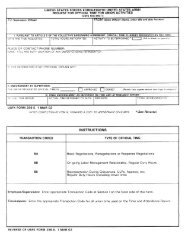AK Pam 750-6 Chemical Agent Resistant Coating.pdf - Eighth Army ...
AK Pam 750-6 Chemical Agent Resistant Coating.pdf - Eighth Army ...
AK Pam 750-6 Chemical Agent Resistant Coating.pdf - Eighth Army ...
You also want an ePaper? Increase the reach of your titles
YUMPU automatically turns print PDFs into web optimized ePapers that Google loves.
Headquarters <strong>Army</strong> in Korea<br />
<strong>Eighth</strong> <strong>Army</strong> <strong>Pam</strong>phlet <strong>750</strong>-6<br />
Unit #15236<br />
APO AO 96205-5236<br />
FOR THE COMMANDER:<br />
TOMMY R. MIZE<br />
Colonel, GS<br />
Chief of Staff<br />
Official:<br />
GARRIE BARNES<br />
Chief, Publications and<br />
Records Management<br />
Maintenance of Supplies and Equipment<br />
CORROSION PREVENTION AND CONTROL (CPC) AND<br />
CHEMICAL AGENT RESISTANT COATING (CARC) PROGRAM<br />
*This pamphlet supersedes <strong>AK</strong> <strong>Pam</strong> <strong>750</strong>-6, dated 15 May 2007.<br />
26 April 2013<br />
Summary. This pamphlet provides guidance and establishes procedures for the management of<br />
Corrosion Prevention and Control (CPC) and <strong>Chemical</strong> <strong>Agent</strong> <strong>Resistant</strong> <strong>Coating</strong> (CARC) program,<br />
which will protect equipment from corrosion, provide chemical agent resistance and camouflage.<br />
Summary of Changes. This revision adds information and guidance for Water Dispersible (WD)<br />
CARC painting procedures.<br />
Applicability. This pamphlet applies to all <strong>Eighth</strong> <strong>Army</strong> (8A) units and contractor operated<br />
facilities involved with the application of CARC paint to US <strong>Army</strong> equipment in the Republic of<br />
Korea. It discusses responsibilities, policies, procedures, health and environmental hazards,<br />
safety requirements, and proper disposal of hazardous materials.<br />
Supplementation. Supplementation of this pamphlet and establishment of command and local<br />
forms are not authorized without prior approval from the Commander, <strong>Eighth</strong> <strong>Army</strong> G4 (EAGD-SO)<br />
UNIT #15236, APO AP 96205-5236
Forms. <strong>AK</strong> forms are available at http://8tharmy.korea.army.mil/g1_ag/.<br />
Records Management. Records created as result of processes proscribed by this pamphlet must<br />
be identified, maintained, and disposed of according to AR 25-400-2. Record titles and descriptions<br />
are available on the <strong>Army</strong> Record Information Management System website<br />
https://www.arims.army.mil.<br />
Suggested Improvements. Users of this pamphlet are invited to send comments and<br />
suggestions for improvement on DA Form 2028 (Recommended Changes to Publications and<br />
Blank Forms) to the Commander, <strong>Eighth</strong> <strong>Army</strong> G4 (EAGD-SO) UNIT #15236, APO AP 96205-<br />
5236.<br />
Distribution. Electronic Media Only (EMO).
CONTENTS<br />
Chapter 1<br />
Inspection Policy, page 1<br />
1-1. Purpose<br />
1-2. References<br />
1-3. Explanation of Abbreviations<br />
1-4. Responsibilities<br />
Chapter 2<br />
Policy and Procedures, page 1<br />
2-1. Policies for Painting<br />
2-2. Equipment Processing Procedures<br />
2-3. <strong>Army</strong> Aircraft and Aviation Ground Support Equipment<br />
2-4. Health/Environment Hazards and Safety Requirements<br />
Appendix, page 7<br />
A. References<br />
Glossary, page 8
Chapter 1<br />
Introduction<br />
1-1. Purpose<br />
This pamphlet provides guidance and establishes procedures for the management of Department<br />
of <strong>Army</strong> (DA) Corrosion Prevention and Control (CPC) and <strong>Chemical</strong> <strong>Agent</strong> <strong>Resistant</strong> <strong>Coating</strong><br />
(CARC) painting programs within the <strong>Eighth</strong> <strong>Army</strong> (8A) and its Operational Control (OPCON)<br />
organizations.<br />
1-2. References<br />
Required and related publications and forms are listed in Appendix A.<br />
1-3. Explanation of Abbreviations<br />
Abbreviations used in this regulation are explained in the glossary.<br />
1-4. Responsibilities<br />
a. 8A G4 will provide command direction on CPC and CARC painting programs, and will<br />
designate the 19th Expeditionary Sustainment Command (19th ESC) as the CPC and CARC<br />
painting program manager.<br />
b. 19th ESC will develop and establish policy and procedures, provide staff supervision and<br />
guidance for CARC painting processes to include planning, programming, scheduling, and<br />
execution of the program. 19th ESC will inspect the CARC painting facilities operated by <strong>Army</strong><br />
maintenance units and local Korean contractor operated facilities as required. 19th ESC will be the<br />
8A central collection point for record keeping and will maintain a data file on all equipment that has<br />
been completely repainted.<br />
Chapter 2<br />
Policy and Procedures<br />
2-1. Policies for Painting<br />
a. CARC is the approved coating for all combat and combat support equipment, tactical<br />
vehicles, aircraft, and essential ground support equipment, to include secondary item containers<br />
such as engine, transmission, ammunition containers and appropriate kits. More detailed painting<br />
information and procedures are covered by TM 43-0139 for ground equipment, TB 43-0144 for<br />
watercraft, TM 55-1500-345-23 for army aircraft, and TM 38-470 for APS-4 stocks.<br />
b. Complete repainting should be done only when the existing finish is obsolete (is not longer<br />
suitable for the environment in which the equipment is operated) or has been deteriorated to the<br />
extent that it no longer protects the underlying surface or when higher authority mandates.<br />
Complete repainting for the sole purpose of achieving uniformity or cosmetic purposes is<br />
prohibited.<br />
(1) Materiel Support Center-Korea (MSC-K) is the only <strong>Army</strong> maintenance facility equipped<br />
with CARC painting booths that comply with Occupational Safety and Health Administration<br />
(OSHA) standards for complete repainting. MSC-K will manage the CARC program for their<br />
facilities, to include planning, programming, scheduling and execution. On the last working day of<br />
each month, MSC-K will provide 19th ESC SPO a list of CARC painted equipment during the<br />
1<br />
<strong>AK</strong> PAM <strong>750</strong>-6, 26 April 2013
month. The list will include the following information: LIN, Model, NSN, USA number, serial<br />
number, and owning unit of the equipment.<br />
(2) Bosung Industry CARC painting facility located in Dongducheon accomplishes<br />
complete ground equipment repainting to satisfy the requirements of units in northern area (Area I<br />
& II) and Korean Air Lines (KAL) Co. Ltd painting facility located in Kimhae accomplishes complete<br />
aircraft repainting.<br />
(3) Equipment evacuation for complete repainting procedures must be covered in detail<br />
in the unit Standing Operating Procedures (SOP). Field maintenance units will make final<br />
determination as to which equipment will be completely repainted IAW criteria established in the<br />
unit Standing Operating Procedures.<br />
c. Spot/touch-up painting may be performed by APS-4 and Field maintenance units not<br />
equipped with proper CARC painting booths. Spot/touch-up painting will be performed IAW TB 43-<br />
0242. Touch-up/spot painting will be done for the area of scratches, chips, and marring surface<br />
observed during preventative maintenance checks and services (PMCS) or technical inspection.<br />
Touch-up painting includes restoration of painted surfaces after a repair or a replacement.<br />
Commanders are responsible for requisitioning required personal protective equipment (PPE), i.e.,<br />
protective clothing, gloves, footwear, respirators, paints, primers, thinners, solvents, roller, and<br />
brushes, necessary to support CARC painting operations. Touch-up/spot painting application must<br />
be covered in detail in the unit SOP.<br />
d. Tactical equipment designed for single color CARC requirement will be painted with an<br />
approved color based on contingency mission environment. The appropriate color for Korea based<br />
equipment is woodland green.<br />
e. Vehicles or equipment painted with CARC or WD CARC should always be spot painted with<br />
WD CARC. WD CARC is fully compatible with all existing CARC primers and topcoats.<br />
f. The ambient temperature should be between 60-90F for priming and top coating. The ideal<br />
temperature is 70F with a humidity of 45-50 percent.<br />
g. Do not paint the following with WD CARC unless specific written approval is provided by the<br />
<strong>Army</strong> Material Command (AMC) subordinate command (TACOM, CECOM, AMCOM) responsible<br />
for the management of that commodity:<br />
(1) Painted items that attain surface temperatures of more than 400 degrees Fahrenheit, or<br />
serve a heat-conducting function, or expand and contract during operation (manifolds, turbo<br />
chargers, cooling fins and rubber hoses).<br />
(2) Displacement watercraft that is subject to prolonged salt-water immersion (Logistic<br />
support vessel (LSV) and landing craft utility (LCU).<br />
(3) Non-deployable equipment and fixed installation systems (Railroad rolling stock and<br />
fixed power generation systems).<br />
(4) Installation/TDA equipment such as military police cars, non-tactical fire trucks and<br />
buses.<br />
2<br />
<strong>AK</strong> PAM <strong>750</strong>-6, 26 April 2013
(5) Aluminum transmissions that are enclosed in combat vehicle pack compartment.<br />
However, ferrous components of the transmission must be protected with WD CARC or other rustpreventive<br />
agents.<br />
(6) Items made of fabric or have anodized or parkerized surfaces.<br />
h. WD CARC protected surfaces should not be covered with petroleum or other products to<br />
improve the appearance of the equipment. Use of these products reduces the chemical protection<br />
provided by WD CARC and increases the probability of injury.<br />
i. WD CARC is intended for use over new or previously painted surfaces. It is applied over<br />
pretreated surfaces after priming with epoxy primer. WD CARC can be applied over thoroughly<br />
prepared existing CARC surfaces. It cannot be applied over lacquer.<br />
j. MSC-K and contractor-operated paint facilities will follow their own unique procedures for<br />
paint booth operations. All facilities painting US <strong>Army</strong> equipment will have established written<br />
procedures that may be reviewed by 19th ESC or <strong>Eighth</strong> <strong>Army</strong> personnel, upon request.<br />
k. Major end items and major components with exposed surfaces painted with WD CARC will<br />
have the word "CARC" stenciled on them in close proximity to the data plate.<br />
l. The application of WD CARC consists of four distinct steps; cleaning, pre-treating, priming,<br />
and top coating. After proper surface preparation and pretreatment, exteriors will be painted with<br />
primer or topcoat.<br />
m. Supporting Safety/Environmental Offices will conduct a quarterly survey and evaluation of<br />
all work centers that use or store CARC paint and provide assistance and guidance.<br />
NOTE: The CARC inventory has only two topcoat available offering lower Volatile Organic<br />
Compounds (VOC) and zero hazardous air pollutants (HAPs). Those are solvent-based CARC<br />
and Water Dispersible (WD) CARC. The solvents used to thin CARC contain high concentrations<br />
of VOCs. On the other hand, WD CARC is thinned with the de-ionized water further reducing the<br />
VOC concentration. In comparison, WD CARC has very low VOC level. To reduce health and<br />
environmental hazard, it is required that all equipment will be completely repainted or touchup/spot<br />
painted with WD CARC if available. The WD CARC painting procedures are covered in<br />
TM 43-0139 and TB 43-0242. National Stock Numbers (NSNs) for wash primer, CARC primer,<br />
and topcoat are found in TM 43-0139 or TB 43-0242.<br />
2-2. Equipment Processing Procedures<br />
a. Complete Repainting:<br />
(1) Once determination has been made by the Field maintenance to do a complete<br />
repainting, the owning unit must provide a memorandum for fund citation to 19th ESC SPO<br />
(EANC-DGM-MAD), Unit #15015, APO AP 96218-5015, with the following information: LIN,<br />
Model, NSN, USA number, serial number, name of owning unit, and the date of equipment turnedin.<br />
Equipment scheduled for Theater Sustainment Repair Program (TSRP) will not be job ordered<br />
for complete repainting.<br />
(2) When determination has been made by APS-4 to do a complete repainting, a cost<br />
reimbursable job order will be initiated by AFSBn-NEA Production Control Division and turned into<br />
MSC-K Production Control Division. The job order will be accompanied with the following<br />
3<br />
<strong>AK</strong> PAM <strong>750</strong>-6, 26 April 2013
information: type of vehicle/equipment, bumper number, USA number, serial number, name of<br />
owning unit, and the date of equipment turned-in.<br />
(3) When using contractor-operated facilities, units are required to coordinate their<br />
requirements directly with 19th SPO for an induction schedule. Under the current contract, units<br />
are not required to provide any funding for material, labor or transportation to or from the paint<br />
facility. Units will be notified if there is any change to this policy.<br />
(4) MSC-K, located at Cp Carroll, Waegwan, services all areas on the peninsula for<br />
equipment in the TSRP. Equipment not enrolled in the TSRP will be job ordered as unscheduled<br />
maintenance known as the Theater Sustainment Repair and Return (TSRR). When a piece of<br />
equipment is submitted to MSC-K for TSRR, the unit is responsible for material. Other than <strong>Army</strong><br />
units are required to reimburse MSC-K for material and labor.<br />
b. Spot/Touch-up Painting. Painting at Field maintenance not equipped with a proper CARC<br />
paint boot is limited to touch-up or spot painting using a brush or a roller. Touch-up kits are<br />
available as an aerosol or as a non-aerosol with a sponge roller or brush applicator. NSNs are<br />
listed in TB 43-0242.<br />
(1) Spot Painting. When a CARC/WD CARC painted surface is scraped, scratched or<br />
damaged, its resistance to chemical agents is lessened and it becomes susceptible to corrosion.<br />
Depending on the location and size of the area damaged, spot painting may be required. Use WD<br />
CARC only when you have to spot paint equipment painted with CARC. Likewise, only use WD<br />
CARC for adding unit identification markings (bumper markings).<br />
(2) Touch-up painting. Touch-up painting is done to prevent corrosion, not for purely<br />
cosmetic reasons. If the paint is marred but not deep enough to see bare metal, you do not need<br />
to paint. Steps for touch-up painting will be IAW TB 43-0242.<br />
2-3. <strong>Army</strong> Aircraft and Aviation Ground Support Equipment<br />
a. CARC is the approved coating for all <strong>Army</strong> aircraft and Aviation Ground Support Equipment.<br />
Touch-up/spot painting of aircraft surfaces with CARC is authorized. Complete repainting of <strong>Army</strong><br />
aircraft will be with single color CARC paint and the aircraft will be painted with a color based on<br />
the contingency mission environment. Instructions and procedures for the painting and marking of<br />
all <strong>Army</strong> aircraft, including standard approved materials, application and maintenance of coatings,<br />
finishing materials, special purpose coatings and markings, insignia, and identification markings<br />
are covered by TM 55-1500-345-23.<br />
b. MSC-K and contractor-operated CARC paint facilities will be utilized for complete repainting<br />
of Aviation Ground Support Equipment. Only contractor-operated facilities are authorized to paint<br />
the <strong>Army</strong> aircraft.<br />
c. 19th ESC SPO will determine and establish the location (CONUS versus local aircraft<br />
maintenance facilities) and method (contract or evacuation) for complete repainting of the aircraft.<br />
d. Field Level:<br />
(1) Limited minor touch-up/spot painting of aircraft surfaces using CARC will be IAW TM<br />
43-0139 and TM 55-1500-345-23. Use a brush or one quart spray bottle for scratches, chips, or<br />
marring of painted surfaces.<br />
4<br />
<strong>AK</strong> PAM <strong>750</strong>-6, 26 April 2013
(2) Aviation ground support equipment painted with CARC will have the word ‘CARC’<br />
stenciled near the data plate in black, using one-inch letters.<br />
(3) Aircraft requiring a complete CARC repainting as determined by supporting Aviation<br />
Maintenance Company (AMC) will be reported through the Brigade Aviation Maintenance Office<br />
(BAMO) to 19th ESC SPO (EANC-DGM-MAC, 768-8238/ 8237).<br />
2-4. Health/Environmental Hazards and Safety Requirements<br />
a. Vapor<br />
(1) Spray painting results in significant aerosolization of paint and solvents. Painting<br />
materials may also contain lead, zinc chromate, chromium VI and hexamethylene diisocynate<br />
(HDI). Exposure to solvent is expected in confined spaces during the brush or roller painting,<br />
drying or curing process. Welding and cutting operations on CARC coated metal can release<br />
significant quantities of isocyanate.<br />
(2) Every effort must be made to ensure proper ventilation of paint area to rid the area of<br />
toxic vapors as quickly as possible. All personnel must be made aware of dangerous toxic vapors<br />
generated by CARC paint and trained on the use of proper respirator and other PPE. An effective<br />
respiratory protection program and use of PPE must be incorporated into SOP to safeguard the life<br />
and health.<br />
b. Fire<br />
(1) The mist generated from spray gun is highly flammable. Open cans containing paint<br />
removers, thinners, paints, primers, and oil or solvent-soaked cloths are a fire hazard.<br />
(2) Accurate mixing of two component coatings, according to instructions provided with<br />
each kit, is crucial since sufficient amounts of material cause chemical polymerization to occur.<br />
Mixing must be conducted in a well ventilated mixing room or spraying area away from any open<br />
flames, welding torches, and combustion heaters. All mixing containers must be dry and clean,<br />
and personnel doing the mixing must wear eye protection and other PPE to ensure a full<br />
protection.<br />
c. Contact with Paint Material<br />
(1) Skin contact with paints, primers, removers and thinner can convey toxic materiel to<br />
food or water during the whole paint process.<br />
(2) Avoid skin contact with paint material. Personal protective equipment will be worn to<br />
prevent skin contact.<br />
d. Dust and Noise<br />
(1) Grinding and sanding painted surfaces can expose personnel to hazardous dust with<br />
high concentrations of lead, zinc, copper, tin, chromium VI, and noise and eye injury hazard.<br />
(2) Approved respirators, eye, and hearing protection must be used during grinding and<br />
sanding operation, and the area must have a noise and eye protection hazards signs posted.<br />
5<br />
<strong>AK</strong> PAM <strong>750</strong>-6, 26 April 2013
e. Material Safety Data Sheets (MSDS): MSDS are prepared by the manufacturer and should<br />
accompany each single shipment or batch of paint, primer and thinner. Along with the product<br />
ingredients and specific protection information, the MSDS contains reactivity data, spill and<br />
disposal procedures, fire and explosion hazards, and health hazards data. It is a law that<br />
personnel working with these substances read and understand this critical information, and MSDS<br />
must be posted or filed in a location readily accessible to all workers exposed to the substances.<br />
Because of the variations involved, the MSDS must be reviewed for each shipment procured on a<br />
single purchase order. MSDS also assist management by directing attention to a need for specific<br />
control engineering, work practices and protective measures to ensure safe handling and use of<br />
material.<br />
f. Medical Surveillance: Medical surveillance to detect adverse health effects will be<br />
determined by the installation medical authority (IMA) based on the specific constituents of the<br />
coating. In general, medical surveillance is required for anyone who works 30 or more days per<br />
year in paint operations where respiratory protection is required. Personnel involved in painting at<br />
Field/Sustainment maintenance will normally require surveillance. Vehicle and equipment<br />
operators and unit maintenance section personnel usually do not perform enough touch-up<br />
painting to warrant a medical surveillance. For military personnel who require medical surveillance,<br />
the supervisor must inform the supporting Medical Facility. For civilian workers, the Civilian<br />
Personnel Advisory Center (CPAC) must be notified of individual’s entry requirement into the<br />
surveillance program. The CPAC is responsible for scheduling an individual for health screening<br />
and exams.<br />
g. Storage: Paint thinner and supplies must be stored in an area that meets OSHA and local<br />
environmental standards. All opened cans containing paint, paint removers and thinners must be<br />
covered tightly before being stored.<br />
h. Disposal: Unusable paint mixtures, paint components, primers, and thinners are considered<br />
hazardous waste that require a special handling and disposal in accordance with Federal, DOD,<br />
DA, local command, and host nation’s hazardous waste regulations. Contractor-operated facilities<br />
will comply with Korean disposal and environmental laws and policies. Contractors will make<br />
coordination with the Administrative Contracting Officer for proper disposal guidance. This also<br />
applies to dried paint and primer waste. All military units must contact their Environmental Control<br />
Officer (ECO) for proper disposal guidance.<br />
6<br />
<strong>AK</strong> PAM <strong>750</strong>-6, 26 April 2013
Appendix A<br />
References<br />
AR <strong>750</strong>-1, <strong>Army</strong> Materiel Maintenance Policy<br />
(Available at http://www.army.mil/usapa/epubs/index.html)<br />
AR <strong>750</strong>-59, <strong>Army</strong> Corrosion Prevention and Control Program<br />
(Available at http://www.army.mil/usapa/epubs/index.html)<br />
PS Magazine, The Preventive Maintenance Monthly, Issue 668, July 2008, “Spot Painting Easier<br />
with WD CARC” (Available at https://www.logsa.army.mil/psmag/pshome.cfm)<br />
TM 38-470, Storage and Maintenance of <strong>Army</strong> Prepositioned Stock Materiel<br />
(Available at https://www.logsa.army.mil/etms/index.cfm)<br />
TM 43-0139, Painting Instructions for <strong>Army</strong> Materiel<br />
(Available at https://www.logsa.army.mil/etms/index.cfm)<br />
TB 43-0144, Painting of Watercraft<br />
(Available at https://www.logsa.army.mil/etms/index.cfm)<br />
TB 43-0213, Corrosion Prevention and Control (CPC) for Tactical Vehicles (Available at<br />
https://www.logsa.army.mil/etms/index.cfm)<br />
TB 43-0242, WD CARC Spot Painting<br />
(Available at https://www.logsa.army.mil/etms/index.cfm)<br />
TM 55-1500-345-23, Painting and Marking of <strong>Army</strong> Aircraft<br />
(Available at https://www.logsa.army.mil/etms/index.cfm)<br />
TB MED 502, Occupational and Environmental Health Respiratory Protection Program<br />
(Available at http://chppm-www.apgea.army.mil/tbm.htm)<br />
TG No. 144, Guidelines for Controlling Health Hazards in Painting Operations<br />
(Available at http://chppmwww.apgea.army.mil/documents/TG/TECHGUID/TG144.<strong>pdf</strong>)<br />
USFK Reg 201-1, Environmental Governing Standard (Available at<br />
http://8tharmy.korea.army.mil/G1_AG/index.htm<br />
USARPAC Policy on: <strong>Army</strong> Corrosion Prevention and Control Program (CPCP) Policy<br />
Memorandum 04-09<br />
7<br />
<strong>AK</strong> PAM <strong>750</strong>-6, 26 April 2013
Glossary<br />
Abbreviations<br />
8A <strong>Eighth</strong> <strong>Army</strong><br />
19th ESC 19th Expeditionary Sustainment Command<br />
AFSBn -NEA <strong>Army</strong> Field Support Battalion-North East Asia<br />
AMC <strong>Army</strong> Material Command<br />
AMC Aviation Maintenance Company<br />
AMCOM Aviation and Missile Command<br />
BAMO Brigade Aviation Maintenance Office<br />
CARC <strong>Chemical</strong> <strong>Agent</strong> <strong>Resistant</strong> <strong>Coating</strong><br />
CECOM Communications-Electronics Command<br />
CPAC Civilian Personnel Advisory Center<br />
CPC Corrosion Prevention and Control<br />
DA Department of <strong>Army</strong><br />
DOD Department of Defense<br />
ECO Environmental Control Officer<br />
HAPs hazardous air pollutants<br />
HDI Hexamethylene Diisocynate<br />
IAW in accordance with<br />
IMA Installation Medical Authority<br />
KAL Korean Air Lines Co. Ltd<br />
LCU landing craft utility<br />
LIN Line Item Number<br />
LSV Logistic support vessel<br />
MSC-K Materiel Support Center-Korea<br />
MSDS Material Safety Data Sheets<br />
8<br />
<strong>AK</strong> PAM <strong>750</strong>-6, 26 April 2013
NSNs National Stock Numbers<br />
OSHA Occupational Safety and Health Administration<br />
OPCON Operational Control<br />
PMCS preventative maintenance checks and services<br />
PPE personal protective equipment<br />
SOP Standing Operating Procedures<br />
SPO Support Operations Office<br />
TACOM Tactical Command<br />
TDA Table of Distribution and Allowance<br />
TSRP Theater Sustainment Repair Program<br />
TSRR Theater Sustainment Repair and Return<br />
VOC Volatile Organic Compounds<br />
WD Water Dispersible<br />
9<br />
<strong>AK</strong> PAM <strong>750</strong>-6, 26 April 2013


